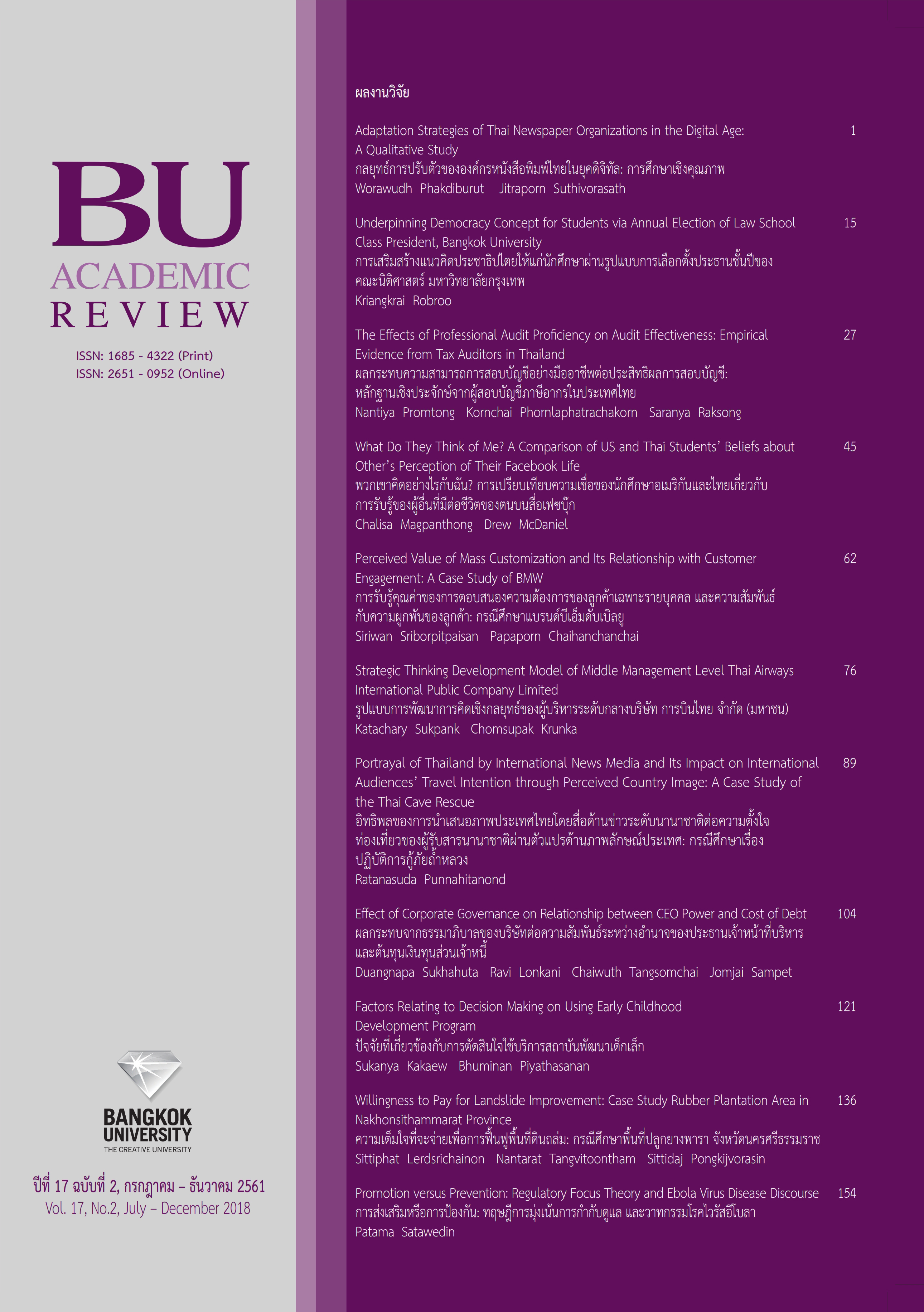Portrayal of Thailand by International News Media and Its Impact on International Audiences’ Travel Intention through Perceived Country Image: A Case Study of the Thai Cave Rescue A Case Study of the Thai Cave Rescue
Main Article Content
Abstract
Most international media coverage of Thailand involve negative issues such as AIDS, prostitutes, and pollution. The successful rescue operation of the 12 lost boys and their young soccer coach in the Tham Luang Cave in Chiang Rai, the Northern Province of Thailand has become worldwide sensation. Using the “4D Model” of the country image as its theoretical framework, this study aims to investigate an overall image of Thailand framed by international news media, and to examine whether the impact of audiences’ exposure to media portrayal of the Thai cave rescue on their intention to visit Thailand is mediated by their country image. A mixed research method – textual analysis and survey -- was used to answer both research questions.
In terms of textual analysis, 50 online news reports purposively selected from five international news media namely CNN, BBC, Al Jazeera, News.com.au, and Channel News Asia between June 23 and August 20, 2018 were textually analyzed to identify the emerging themes of Thailand’s country image in terms of its media portrayal. The Constant Comparative Method (Strauss & Corbin, 1990) reveals that Thailand was portrayed by international news media as a country of efficient performance, impressive competences, aesthetic qualities, and people with Buddhist virtues and high spirit.
As for the survey, an online survey was conducted with 369 foreigners to test three research hypotheses. A Stepwise Hierarchical Multiple Regression Analyses yielded that international audiences’ exposure to the media coverage of the Thai cave rescue significantly influenced cognitive components of the country image, which in turn, influenced affective component of the country image, which ultimately affected their travel intention. Findings provide not only academic implications for communication scholars, but also managerial implications for government offices dealing with country image and tourism promotion such as the Ministry of Foreign Affairs and the Tourism Authority of Thailand.
Article Details
The manuscript submitted for publication must be the original version, submitted only to this particular journal with no prior acceptance for publication elsewhere in other academic journals. The manuscript must also not violate the copyright issue by means of plagiarism.
References
Avraham, E. (2000). Cities and their news media images. Cities, 17(5), 363 – 370. DOI:10.1016/S0264-2751(00)00032-9.
BBC. (2018). Retrieved from https://www.bbc.com/news/world/asia
BBC. (2018). The full story of Thailand’s extraordinary cave rescue. Retrieved from https://www.bbc.com/news/world-asia-44791998
Brewer, P. R., Graf, J., & Willnat, L. (2003). Priming or framing media influence on attitudes toward foreign countries. Gazette, 65(6), 493 – 508. Retrieved July
3, 2012 from https://ics-www.leeds.ac.uk/papers/pmt/exhibits/1813/mediaforeign.pdf.
Buhmann, A., & Ingenhoff, D. (2015a). Advancing the country image construct from a public relations perspective: From
model to measurement. Journal of Communication Management, 19(1), 62 – 80.
Buhmann, A., & Ingenhoff, D. (2015b). The 4D model of the country image: An integrative approach from the perspective of communication management. The
International Communication Gazette, 77(1), 102-124.
Blume, B. (2018). Rebranding Thailand in a dark cave. Facebook: Burton on Branding. Retrieved July 23, 2018 from
https://www.facebook.com/454480918305661/posts/rebranding-thailand-in-a-dark-cave-by-burton-blumeyou-may-not-realize-it-but-tha/
95215210898898/
Channel News Asia. (2018). Retrieved from https://www.channelnewsasia.com/news/asia
CNN. (2018). Retrieved from https://edition.cnn.com/world
Cozort, D., & Shields, J. M. (2018). Handbook of Buddhist ethics. Oxford: Oxford University Press.
de Beer, A. S. (2010). News from and in the “dark continent”: Afro-pessimism, news flows, global journalism and media regimes. Journalism Studies, 11(4),
596-609. Retrieved March 17, 2012. DOI: 10.1080/14616701003638509.
DeFleur, M. L., & Plax, T. G. (1980). Human communication as a biosocial process. International Communication Association Conference.
Dimitrova, D., & Strömbäck, J. (2005). Mission accomplished? Framing of the Iraq war in the elite newspapers in Sweden and the United States. Gasette,
67(5), 399 – 417. Retrieved July 3, 2012. DOI: 10.1177/0016549205056050.
Dimitrova, D. V., & Connolly-Ahern, C. (2007). A tale of two wars: Framing analysis of online news sites in coalition countries and the Arab world during the
Iraq war. Howard Journal of Communications, 18(2), 153 – 168. Retrieved April 3, 2012. DOI: 10.1080/10646170701309973.
Fan, Y. (2006). Banding the nation: What is being branded? Journal of Vacation Marketing, 12(1), 5 – 14.
Hagos, A. (2000). Hardened images: The Western media and the marginalization of Africa. Trenton, NJ: Africa World Press, Inc.
Hofstede, G. (1991). Cultures and organizations: Software of the mind. London: McGraw-Hill.
Jenes, B., & Simon, J. (2017). Measuring country image and country brand: Theory and practice. Abstract for the Doctoral Seminar of the 1st European
Marketing Academy (EMAC) Regional Conference. Retrieved August 5, 2018 from https://www.efos.unios.hr/makromarketing/wp.../ measuring_
country_image-seminar.pdf
Jenes, B. (2007). Connection between the ecologically oriented consumer behaviour and country image. Marketing and Management, 6, 34 - 43.
Kotler, P., Haider, D., & Rein, I. (1993). Marketing places: Attracting investment and tourism to cities, states and nations. The Free Press, 141.
Maher, A. A., & Carter, L. L. (2011). The affective and cognitive components of country image: Perceptions of American products in Kuwait. International
Marketing Review, 28(6), 559 – 580. DOI: 10.1108/02651331111181411.
Martin, I. M., & Eroglu, S. (1993). Measuring a multi-dimensional construct: Country image. Journal of Business Research, 28, 193. DOI: 10.1016/0148-
2963(93)90047-S
News.com.au. (2018). Retrieved from https://www.news.com.au/world/asia
Nuttavuthisit, K. (2007). Branding Thailand: Correcting the negative image of sex tourism. Place Branding and Public Diplomacy, 3(1), 21 – 30. Retrieved
August 12, 2018 from https://link.springer.com/article/10.1057/palgrave.pb.6000045
Papadopoulos, N., Heslop, L.A., & Berács, J. (1990). National stereotypes and product evaluations in a socialist country. International Marketing Review, 7(1),
32-46.
Rittichainuwat, B. N., Qu, H., & Brown, T. J. (2001). Thailand's international travel image: Mostly favorable. Cornell Hotel and Restaurant Administration
Quarterly, 42(2), 82 – 95.
Roth, K. P., & Diamantopoulos, A. (2009). Advancing the country image construct. Journal of Business Research, 62, 726-740.
Strauss, A., & Corbin, J. (1990). Basics of qualitative research: Grounded Theory procedures and techniques. Newbury Park: Sage.

